Special: Now you see it, now you don't.
Stealth games have always been a little different. Where shooters offer wild, white-knuckled action so fast you often don't have time to think, the stealth game delivers steady, slowly building tension. Where the RTS offers the strategic challenge of controlling dozens of units at once, the stealth game is generally about tactics in the small: two men, a knife, and a couple of very important questions.

With a stealth game, your heart pounds and your adrenaline flows because of what could happen next as much as for what actually is happening now. Will I make it to the next shadow in time? Will the guard see me? The questions race through your mind as you move through the maps, and then you freeze in your hiding place and wait. You only know you were successful when nothing happens: the guard continues his patrol and you realize you're sweating and squeezing your mouse and holding your breath. Great stealth gaming is something like a problem to be solved: the emphasis is on thinking your way through a situation rather than just shooting everything that moves.
Old School
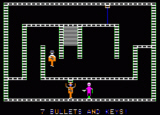
It turns out that the stealth game is as about as old as computer gaming itself. When long-time gamers start talking about their Apple IIs and their Commodore 64s, they inevitably start talking about games like Choplifter and Ultima, not to mention a little game called Castle Wolfenstein. In Wolfenstein, players maneuvered through level after blocky level, collecting secret documents, avoiding guards, stealing uniforms for disguises, and drinking schnapps hidden in locked chests. Silas Warner programmed the game in 1981 for Muse Software, and he knocked everyone's socks off by including actual voices: when soldiers spotted the player, they shouted in German and when they died, they screamed a satisfying death wail. In short, it was a veritable feast of 8-bit goodness.
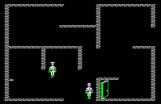
In what's either a testament to Warner's imagination or an indication of the stagnation of the genre, Wolfenstein included features that are standard fare for the sneakers of today. Despite the blocky visuals that truly relied on the players' imaginations to connect the dots, players could search bodies, pick locks and disguise themselves in order to avoid detection. Careless play would also result in an alarm that would put the whole castle on the alert. And in the sequel, Beyond Castle Wolfenstein, the player was armed with a dagger for true stealth kills. Enthusiasts are also quick to point out that this game inspired Id software's John Romero and John Carmack into creating Wolfenstein 3D. Although that iteration wasn't a stealth game, it did pave the way for their creating the Doom and Quake series, both PC landmarks no matter how you look at it.
Sneaking with Snake
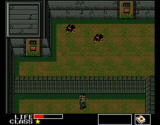
Of all the series discussed here, Metal Gear is by far the longest-running, with a full twenty years under its belt and games released on nearly every platform from the MSX2, C64 and NES to the Game Boy Color, PlayStation, PS2, PC and Xbox, not to mention an upcoming installment for the PS3 scheduled for release in 2007. It's definitely a contender for longest-running game series of any sort, and it has survived multiple sequels in multiple incarnations, from a 2-D isometric view to 3-D, 3rd person views, from stealth to shooter, from turn-based collectible card game to digital graphic novel.
Metal Gear first hit Japan on the MSX2 computer back in 1987, picking up on the stealth mechanic where Castle Wolfenstein left off. Instead of putting the player in control of an expert warrior with a brace of weapons and unlimited ammo, the first Metal Gear revolved around a green operative code named Solid Snake, who was deep inside enemy territory without so much as a pistol for self-defense. The game shifted the action from the wild firefights popular in other games of the day to a controlled stealth mode which required players to avoid confrontation whenever possible, at least until some of the more potent weapons could be found and the boss enemies started cropping up. Detection was based on a straight line-line-of-sight mechanic: if the player passed in front of an enemy, the game went into УAlert ModeФ until either all alerted enemies were killed or the player moved off long enough to let things calm down. This early game ramped up the stealth challenge by including security cameras and sensors that could also set off alerts.

Metal Gear truly came into its own in 1998, when Metal Gear Solid was released for the PlayStation. Basically, the gameplay of the new version remained true to its 1987 roots, so much so that some items popular in the original were ported directly into the sequel. Once again, Snake could disguise himself with a cardboard box and use his cigarette smoke to reveal laser alarm sensors. The game also won much praise for its visuals and for the fact that it ventured into true 3-D territory with environments fully modeled in three dimensions. While the quality of the visuals and audio were almost universally praised as УcinematicФ with a rich storyline, some gamers registered their complaints that the non-interactive cutscenes overwhelmed the gameplay.
Still, Metal Gear Solid brought a few gameplay elements to the table that are now indispensable to stealth play and also important to other gaming genres. The newly-solid Snake was able to crouch and hide behind crates and walls in order to avoid detection by the guards and cameras. Unfortunately, like some other stealth games, guards in Metal Gear evidently had a very limited range of vision, and as long as you stayed far enough away from them, you could play the system and avoid detection. Crawling also brought with it a new location: air ducts. Anyone who has played just about any first-person perspective game will know that the air duct is just about as ubiquitous these days as the supply crate. Where the crate offers УsecretФ caches of ammo and health, the air duct is a supposedly clever way to bypass enemies and traps, or simply access areas behind locked doors. Players of Splinter Cell and Deus Ex gamesЧnot to mention Syphon Filter, Half-Life and a hundred othersЧwill be intimately familiar with the world of the air duct.

Twenty years on and with more titles in its catalog than would be possible to mention here, the Metal Gear franchise shows no signs of slowing down. With no fewer than three titles released in 2006 for the PSP, including Portable Ops, one of the most praised game for that handheld platform, Solid Snake seems to have plenty of wind yet in his sails. 2007 will see the release of Metal Gear Solid 4: Guns of the Patriots, which will not only feature plenty of next-gen PS3 goodness, but also an УOld SnakeФ rumored to be at the end of his career. And Konami is in negotiations with Sony Pictures concerning a Metal Gear Solid slated for release in 2008. Don't worryЧalthough it doesn't look like a director is yet attached to the picture, it won't be Uwe Boll. What's more, Hideo Kojima, designer and writer for Metal Gear since the first installment, is credited so far as the only writer of the screenplay.
Granddaddy Garrett
What can you say about the game that not only defined the stealth genre for millions of PC gamers but also added the word УtafferФ to their vocabulary? Released in late 1998, Thief: The Dark Project put players in the shoes of Garrett, a young main raised to be a master thief in a faux medieval world that included a fair dash of steam-powered technology. The game placed an evil religious cult at odds with a secret guild of thieves with the wisecracking Garrett caught between the two. It was followed in 2000 by Thief II: The Metal Age and in 2004 by Thief: Deadly Shadows, and although both are good games, neither sequel really knocked it out of the park with the general public like the original did.
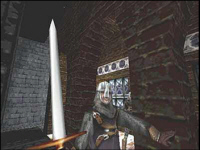
If Wolfenstein set the stealth stage, Thief ruled the stealth roost for years and set the standard for stealth games to this day. With Thief, Looking Glass Studios added depth to PC gaming. Garrett's missions required remain undetected, and often required him not to engage enemies in combatЧalthough there was a combat system, it wasn't all that well-developed and fighting really wasn't the most interesting way to complete the missions. Played on УexpertФ difficulty level, some missions would result in failure if the player killed any character at all. This wasn't just some mindless shooter designed to test players' twitch skills. Like the original Metal Gear before and many stealth games to follow, Thief was something of a puzzle game: it tested how well you could solve a problem with a limited set of tools. The levels offered a series of moving guards, monsters, and annoyingly placed torches, and all Garrett carried to get around them was a bow, the occasional potion, and his trusty blackjack. The bow was an all-purpose tool of sorts, since the game offered fire arrows, rope arrows (a grappling hook of sorts), noisemaker arrows (to distract enemies), moss arrows (which provided a soft, quiet surface to walk on) and water arrows. The water arrows often proved most useful, since they could extinguish torches to allow easier passage through certain areas, and the game often felt like an exercise in managing a limited supply of water arrows.
Playing a stealth game well requires patience. In Thief, the wisest course of action was often to wait in the shadows and watch for a bit to determine the guards' preferred patrol routes. Patience also paid off when the player thoroughly searched an area to find all possible gold hidden throughout a level. The game tracked the amount of gold found versus the total amount hidden and served as a sort of score for dedicated players. Some of the levels in the original game were huge and offered a truly immersive experience where you'd have to sneak quietly and patiently through the rooms of a castle or halls of a dungeon in search of a key or a shiny little something.
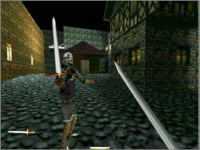
Thief brought one of the most important technical innovations to the genre: usable shadows. Up to this point, stealth games relied on line of sight to determine if the player was concealed or not. If the player was in an NPC's range of vision, the enemy would go into attack mode. But in Thief, a player standing still or moving silently in deep shadow would be invisible even to a guard looking directly at him. Coupled with the conceit of moving silently while crouching, invisibility in shadows allowed for undetected movement and has become a mainstay of stealth games ever since. A glowing gem at the bottom of the screen served as an indicator of how visible the player was at any given time.
Dark Project also featured sound innovations that are now common to games of many genres. It was among the first to use sophisticated audio cues to communicate game world information to the player. The game provided great sound effects like guard chatter and ambient sounds. Every surface that Garrett walked on had a different sound, and subtle effects like these really completed the illusion of a rich world. And its use of 3-D positional audio really augmented the effect. You didn't have to see the guard to know he was approaching. Current triple-A titles still cite 3D positional audio as a selling point.
Unfortunately, the A.I. in the game was often less than stellar, and Thief introduced an element which has has become a standard device in many of the stealth games that followed: the УI must be seeing thingsФ line. It's an out that keeps the game going once the player has been spotted (or nearly so). If the player can stay out of sight long enough, the alerted guard will stand down from alert status and say something like УAm I going crazy?Ф and then go back about his business. It generally makes no sense, but it's pretty much one of those improbabilities that make the genre much more accessible for players who might not want to continually re-start missions after being spotted.
Plenty of players couldn't get enough of the Thief worldЧeven with two sequelsЧand decided to take matters into their own hands. The Thief modding community is still going strong, with new maps produced for both Deadly Shadows and Metal Age throughout 2006 and into 2007. And of course there's Thief 2x: Shadows of the Metal Age, a complete, fan-generated campaign that features thirteen new missions, new weapons, and comes complete with cutscenes and a brand new hero. Other modders were dying for multiplayer Thief, and Black Cat obliged them with the Thievery mod for UT. Black Cat (who also did the excellent Alien Swarm mod for UT2004) is currently working on УNightblade,Ф a team-based multiplayer stealth game set in a very Thief-like world. Although they're working with UT2004 right now, it looks like Nightblade might move to UT3 when the new engine becomes available to modders.